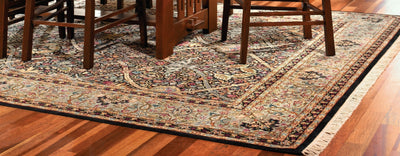
The Many Lives of Mission
Share
 Print
Print
[originally posted June 2021]
In home décor as in life, fashions come and go, and there’s no denying that the original period of Mission furniture’s popularity in America was relatively short. Gustav Stickley’s Craftsman business failed in less than two decades, and in Fayetteville, his brothers Leopold and John George eventually shifted their focus to Colonial Revival, responding to popular tastes in order to stay afloat. So how is it that, more than 120 years on, Stickley Mission furniture is once more alive and well? It helps to look at where Mission began, its return to public attention, and how it’s evolved for modern living.



A brilliant, brief debut
Gustav Stickley made his Arts and Crafts mark by creating a style that rejected Victorian excesses in favor of simple forms, honest American hardwoods (particularly oak), and utility—a piece of furniture that served no purpose had no place in the home he imagined. Americans who shared this desire for simplicity and function caught on quickly, and what came to be known as Mission style became intensely popular. The style evolved a bit during its heyday, incorporating design elements from Harvey Ellis, Peter Hansen, and others, along with new construction techniques developed by Leopold. But over time, they weren’t enough to save it. As world war loomed in the second decade of the 20th century, life became more uncertain, and taste in home furnishings swung back to colonial styles and the comfort of the past. By 1920, Gus had long since filed for bankruptcy, while L. & J.G. Stickley had moved on from Mission to save its business.
Resurfacing
Because Stickley furniture was so well built, original pieces survived in fine condition long after the style’s initial popularity waned. Interest in the American Arts and Crafts movement, and in these Mission antiques, was revived by an exhibition curated by Robert Judson Clark at Princeton University in 1972. This interest grew over the next several years, culminating in a 1988 Christie’s auction that saw Barbra Streisand pay a record $363,000 for a Gustav Stickley sideboard. Alfred and Aminy Audi, owners of L. & J.G. Stickley since 1974, read these signs of renewed interest in their brand’s legacy style, and they knew they had the means to bring Mission to life again. Studying old records, catalogs, and borrowed antiques, Alfred Audi and designer William DeBlaay were able to recreate designs for more than 30 original Stickley pieces; manufacturing began, and the company reissued the Mission Oak Collection in April 1989.



The renaissance of Mission Oak
The 1989 Mission Oak Collection catalog is the story of old made new again. Piece after piece shows the same pure lines and fine materials that could be traced back to Gustav and Leopold. The catalog also reveals the construction techniques that were preserved along with the designs, giving the reissued furniture the same durability and longevity. To distinguish the reissued pieces from turn-of-the-century antiques, clear identifiers and subtle variations were added, including side-hung, center-guided drawers and invisible dovetailed cross rails. Every piece is signed and dated by a proud craftsperson, and the current Stickley logo is burned in alongside the 1917 co-joined shopmark, ensuring that no reissue would be mistaken for the original. Mission was back, and now it was available to homeowners who craved the Arts and Crafts style but couldn’t afford high-priced antiques. As the Audis predicted, it received an enthusiastic reception.
Growing with the times
This time, Mission did not fade away again after a brief revival. The company heeded the lessons of Leopold, who realized early that a brand could not stay static and thrive. As its first major update, Stickley issued the Mission Cherry Collection in 1991, a smart decision given the wood’s popularity and the company’s reputation for producing fine cherry furniture throughout the 20th century.
It also continued to add Mission pieces, both reissues and adaptations of designs influenced by Harvey Ellis and others. All the while, this classic style was updated with modern features, including new back-cushion styles and contemporary recliner technology on upholstery. And in 2000, Stickley launched its annual Collector Edition: limited-edition Mission pieces inspired by Stickley originals and designed with an eye to versatility and function in today’s homes.


21st-century Mission
Nearly 120 years after the original Mission style was conceived, its descendent was born. The Park Slope Collection, created by new Director of Design Marissa Brown, was unveiled in 2018, and its debt to Stickley’s original vision was unmistakable. There were the reverse-tapered legs, the iconic square spindles, the rich ray-flake grain of quartersawn oak. And yet, the familiar lines and elements had merged with organic curves and become somehow lighter. (A cherry version, with its familiar, flowing grain, also made the most of Park Slope’s beautiful lines.) This was an interpretation of Mission that opened the door to the style’s possibilities. And based on Mission’s longevity in the story of American design, don’t be surprised if there are new chapters still to be written.
Additional sources:
Mrs. Aminy Audi, CEO and Chair of the Board
Amanda Clifford, Director, The Stickley Museum
Gray, Stephen & Robert Edwards, eds. Collected Works of Gustav Stickley. New York: Turn of the Century Editions, 1989.
Gray, Stephen. The Early Work of Gustav Stickley. New York: Turn of the Century Editions, 1987.











